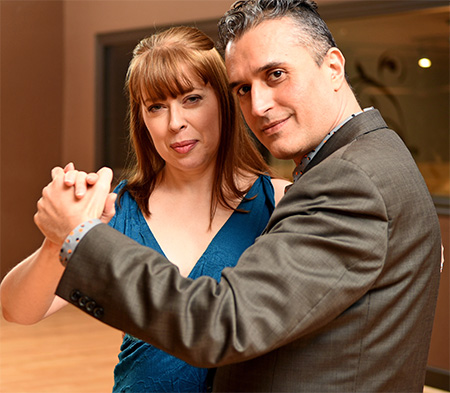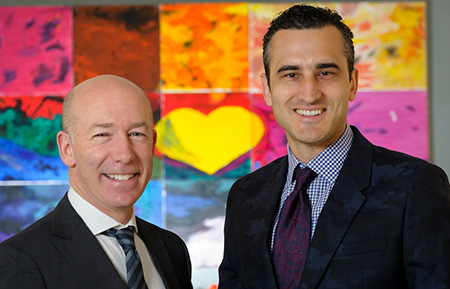A heart attack was so far from Bobbi Lusic’s mind that he didn’t recognize it was happening to him.
A fit 45-year-old tango instructor accustomed to engaging in hour-long cardiovascular workouts, Lusic was helping his mother move to a new apartment on a hot day when he started to experience a tightening of his chest, difficulty breathing, extreme fatigue and a pain that radiated into his arm, neck and jaw.
But he was so resistant to the possibility of a heart attack that he ignored the advice of a 911 operator and drove himself to Surrey Memorial Hospital. Several hours later, with initial test results normal and feeling much better, he checked himself out against the advice of hospital staff, only to return that evening, when an additional test result confirmed a small heart attack.
“It came as a surprise,” he says. “I didn’t consider myself at risk of a heart attack.”
Because he experienced a heart attack at an unusually young age, Lusic was recruited for what may be the largest study of its kind – a province-wide effort by UBC researchers to find people at high risk of premature heart attacks.
The study is not only enrolling people diagnosed with heart disease at a young age – men 50 or younger, women 55 or younger – but also their close blood relatives (parents, siblings or children), in the belief that premature heart disease has a strong genetic component.
“It has never been done at this scale,” said Simon Pimstone, a Clinical Associate Professor in the Department of Medicine and a principal investigator of SAVE BC – the Study to Avoid CardioVascular Events in British Columbia.
Dr. Pimstone was moved to undertake the study after two acquaintances in their 30s – both of them healthy in appearance, diet and activity level – were stunned to discover they had life-threatening heart disease. One, a fellow physician, had a heart attack in his living room that became a near-death experience. The other, a parent at his child’s school, needed a triple bypass.
“It just got me thinking: Why do some young people, who just don’t seem the type, develop coronary disease?” Dr. Pimstone says.
SAVE BC has three goals:
- Collect biological data from people with premature heart disease to gain insights into the lesser understood genetic and molecular origins of heart disease – knowledge that could lead to new strategies for diagnosing and treating the condition in anyone, including older people.
- Develop strategies for managing care of premature heart disease on a long-term basis, to ensure patients are monitored regularly and adhere to their medications.
- Demonstrate the viability of a screening system that captures close blood relatives of those diagnosed with premature heart disease, to determine – long before a heart attack – whether their cardiac function is similarly compromised or threatened.
“Some people are ticking time bombs, and have no idea that they are,” said Liam Brunham, an Assistant Professor in the Department of Medicine who is co-leading the SAVE BC project. “Parents, siblings and children of someone with heart disease have two to ten times the risk of having heart disease compared to their age-matched peers. We want to find them before it’s too late.”
SAVE BC rolled out in Vancouver last year, is expanding this year to Victoria, and Dr. Pimstone and Dr. Brunham plan to include Royal Columbian Hospital in New Westminster and Kelowna General Hospital in 2019. Dr. Pimstone and Dr. Brunham expect to eventually enroll over 1,000 people a year.
So far, SAVE BC has enrolled about 500 people, and is finding vascular disease in 40 per cent to 50 per cent of relatives – most of them people in their 30s and 40s.
Once identified, at first through cholesterol tests and then possibly ultrasound or computerized tomography imaging, they are usually prescribed medication to lower their cholesterol, and possibly to lower their blood pressure and blood sugar as well. They are also given advice about diet and exercise, and warned about smoking.
“It’s much more impactful when people know they have a disease to get them to change behaviour,” Dr. Pimstone says.
Lusic can attest to that. Before his heart attack, he was at the upper end of the normal range for body mass index; now he is squarely in the middle of the range. He also hasn’t touched a cigarette since his heart attack.
Within days of that event, he underwent quadruple bypass surgery. When two bypasses failed, Bobbi had three more surgeries, and four stents implanted.
Surgery revealed that Lusic has particularly small coronary arteries, an inherited condition that contributed to his illness. He also has a particularly “sticky” cholesterol, which is also inherited. Those conditions largely explain why he had four 90 per cent blockages, four 80 per cent blockages and two 40 per cent blockages in the arteries feeding his heart.
That genetic explanation helped to persuade his 68-year-old mother to enrol in SAVE BC – a potentially life-saving decision on her part. The SAVE BC team found that she had the same type of elevated, sticky cholesterol as her son, and substantial blockages in her coronary arteries. They put her on cholesterol-lowering medication and blood thinners.
Lusic made the same pitch to his sister to enroll in SAVE BC, but she hasn’t signed up yet.
“The rest is up to her,” Lusic said. “I’m hoping at some point she will join it.”

